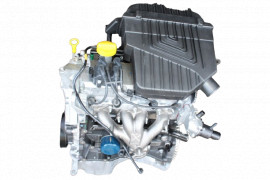Update Your Lorry with a New Opel Corsa Engine
Update Your Lorry with a New Opel Corsa Engine
Blog Article
Exploring the Inner Operation of a Compact Car's Engine System
As motorists, we frequently take for granted the detailed procedures that occur within the boundaries of our car's engine system. The compact yet complicated machinery that propels us ahead is a wonder of engineering precision and control. From the controlled explosions in the burning chamber to the careful timing of fuel shot, every part plays a critical duty in the smooth operation of the engine. In this exploration of a compact lorry's engine system, we will unwind the internal operations of this mechanical harmony, losing light on the secrets that drive us ahead on our daily journeys.
Burning Process Summary
The combustion procedure in a portable automobile's engine system is a critical mechanism that efficiently transforms fuel right into energy to power the lorry. This process happens within the combustion chamber of the engine, where fuel and air mix, fire up, and generate controlled surges. The burning process includes 4 main stages: consumption, power, exhaust, and compression.
Throughout the intake stage, the piston moves downward, attracting in a combination of air and fuel into the combustion chamber. This descending activity generates the power needed to drive the vehicle. This cyclic combustion process is essential to the procedure of a portable vehicle's engine system, guaranteeing efficient energy conversion for propulsion.
Piston and Cyndrical Tube Communication

The piston's accurate fit within the cylinder is necessary for keeping optimum compression and protecting against power loss throughout burning. Limited clearances in between the piston and cyndrical tube wall surfaces make certain reliable securing, permitting the piston to relocate smoothly without enabling gases to leak past. Appropriate lubrication is likewise important to decrease friction and put on in between these parts, boosting longevity and efficiency.
Furthermore, the design and materials made use of in making the piston and cyndrical tube effect engine efficiency and resilience. Modern engines typically utilize lightweight yet durable products like light weight aluminum alloys for pistons and cylinder liners to lower inertia and improve thermal efficiency. On the whole, the unified interaction in between the piston and cyndrical tube is essential to the engine's functionality and total performance.
Gas Injection System Functionality
Gas injection systems in compact lorry engines play an important role in specifically providing fuel to the burning chamber for controlled and reliable ignition. The fuel shot system functions by infusing fuel right into the combustion chamber at the optimum moment throughout the engine's procedure (opel corsa engine). This exact timing guarantees that the fuel mixes uniformly with the air for proper burning, leading to boosted fuel effectiveness and decreased exhausts
There are mainly 2 sorts of gas shot systems utilized in portable automobile engines: port fuel shot (PFI) and direct fuel shot (DFI) PFI systems inject fuel right into the consumption port before the intake shutoff, while DFI systems inject gas straight into the burning chamber. Both systems have their benefits, with DFI offering far better gas atomization and PFI offering a much more cost-effective service.
Recognizing Engine Cooling Mechanisms
Effective operation of a compact vehicle's engine counts greatly on the efficiency of its cooling mechanisms. The air conditioning system in a portable automobile typically consists of numerous elements functioning together to manage the engine temperature level. Understanding these engine cooling systems is important for maintaining the efficiency and durability of a compact lorry's engine system.

Exhaust System Components Explained
The optimum performance of a small view car's engine air conditioning devices depends upon a complementary system called the exhaust system, which makes up various necessary parts for guaranteeing efficient exhausts and engine performance. The exhaust system consists of elements such as the exhaust manifold, catalytic converter, muffler, and tailpipe. The exhaust manifold collects exhaust gases from the view it engine's cyndrical tubes and paths them to the catalytic converter. The catalytic converter after that converts hazardous toxins in the exhaust into much less damaging emissions prior to releasing them via the muffler and tailpipe.
One vital part of the exhaust system is the oxygen sensing unit, which keeps track of the oxygen degrees in the official source exhaust gases to help control gas intake and guarantee optimum engine performance. opel corsa engine. In addition, the resonator might exist in some exhaust systems to decrease sound degrees. Overall, the exhaust system plays a crucial duty in maintaining engine effectiveness, reducing harmful discharges, and making certain a quieter driving experience for compact car owners

Final Thought
In verdict, the compact vehicle's engine system is a complicated mix of components that collaborate to promote the burning process, convert fuel into energy, and get rid of waste gases. Recognizing the internal workings of the engine system, including the piston and cylinder interaction, fuel shot system, engine air conditioning mechanisms, and exhaust system parts, is crucial for maintaining optimal performance and effectiveness of the automobile.
The burning procedure in a portable lorry's engine system is a crucial system that effectively transforms gas right into power to power the automobile.Gas shot systems in small automobile engines play a crucial function in exactly providing fuel to the combustion chamber for efficient and controlled ignition.There are primarily 2 kinds of gas shot systems made use of in portable lorry engines: port gas shot (PFI) and direct fuel injection (DFI) Comprehending these engine cooling mechanisms is vital for keeping the efficiency and durability of a compact vehicle's engine system.
The optimal performance of a small car's engine cooling devices depends on a corresponding system understood as the exhaust system, which makes up various essential parts for making certain effective emissions and engine efficiency.
Report this page